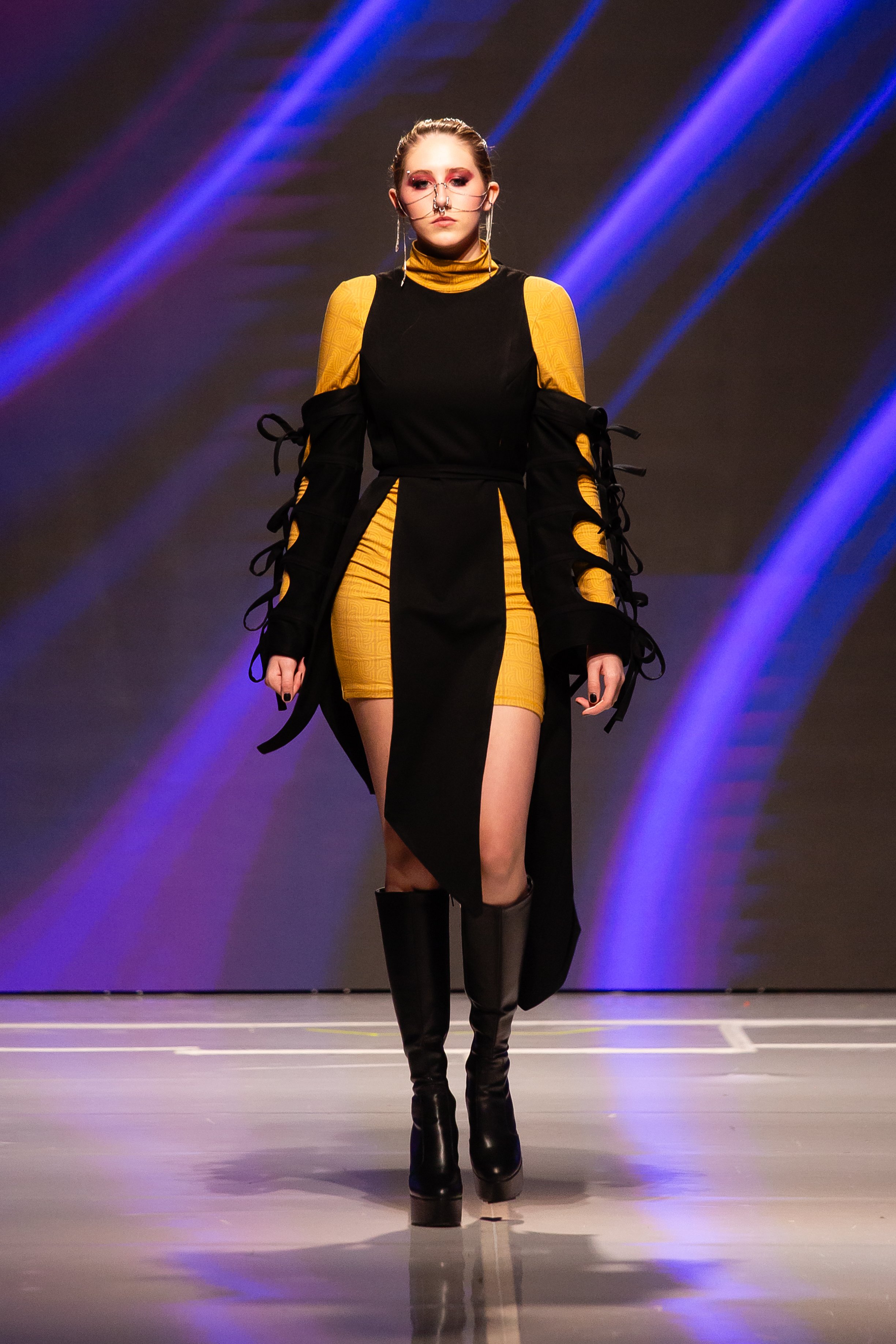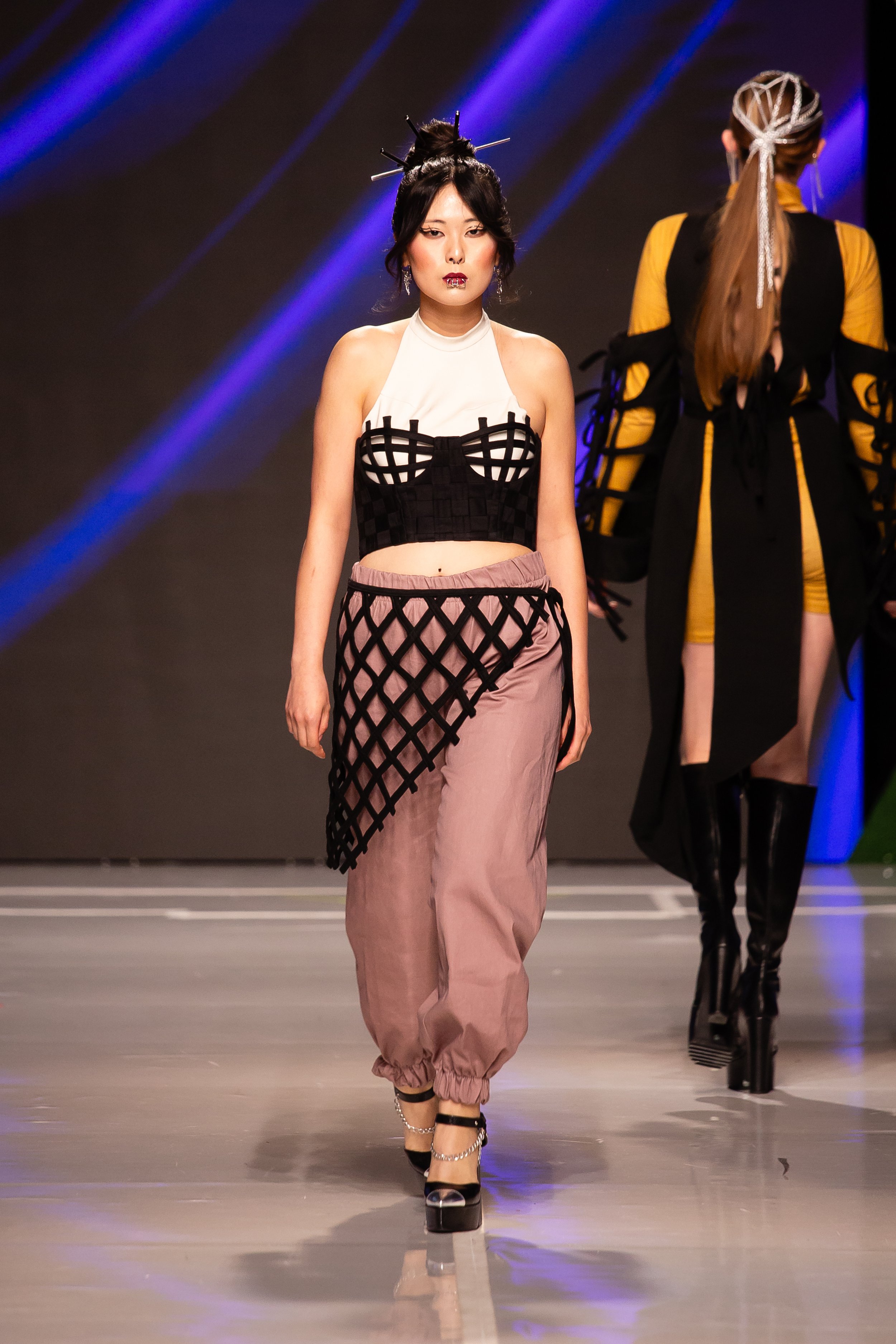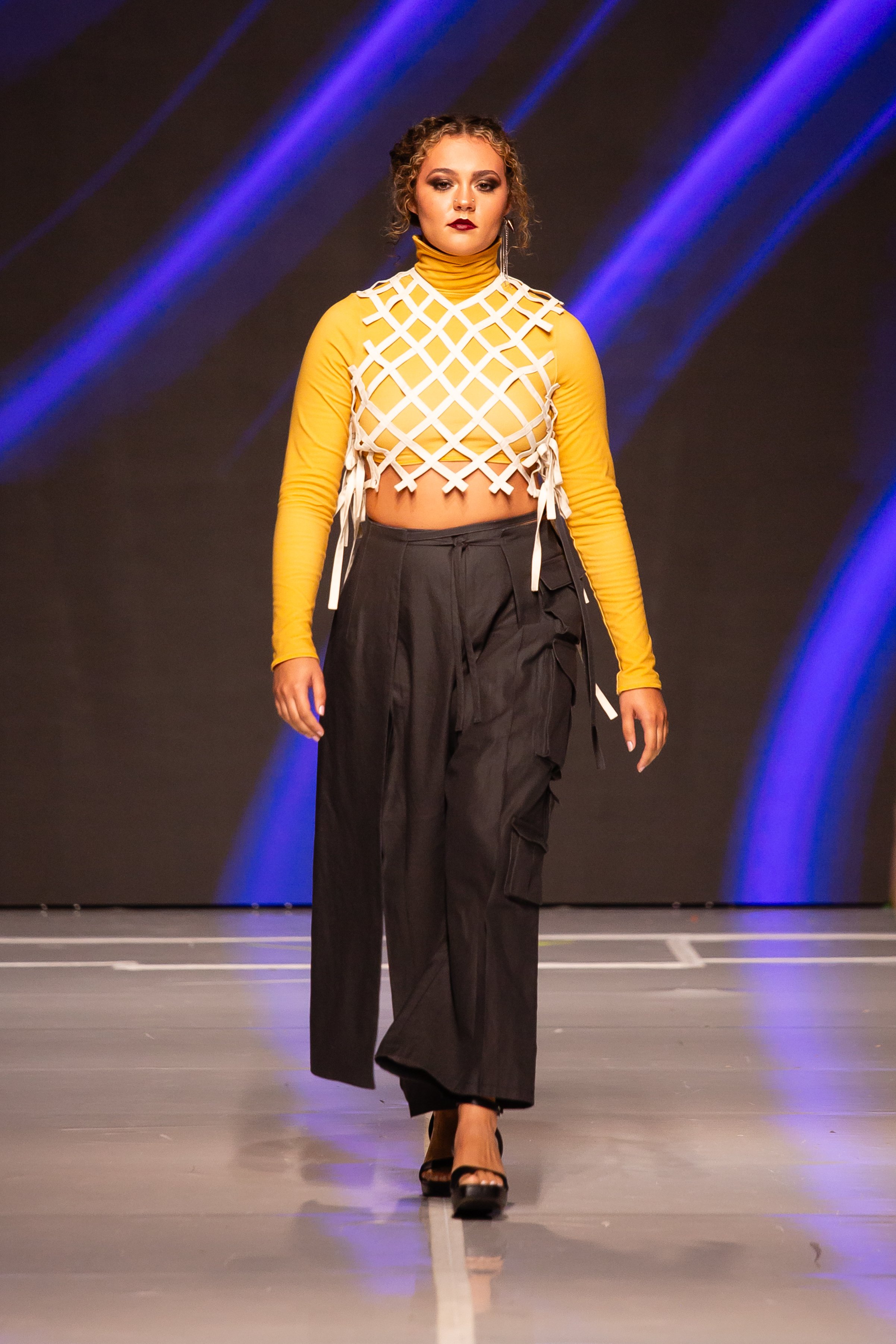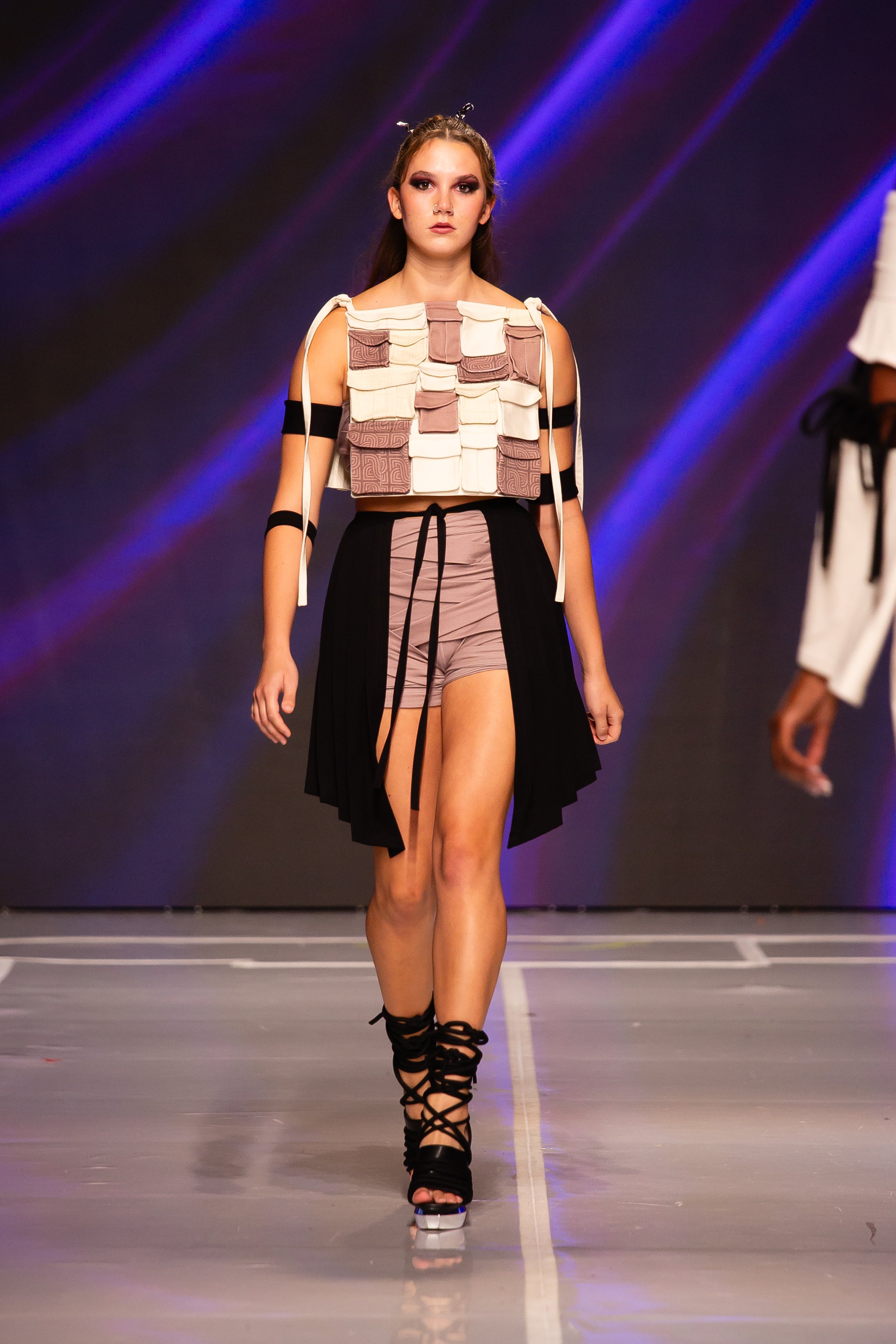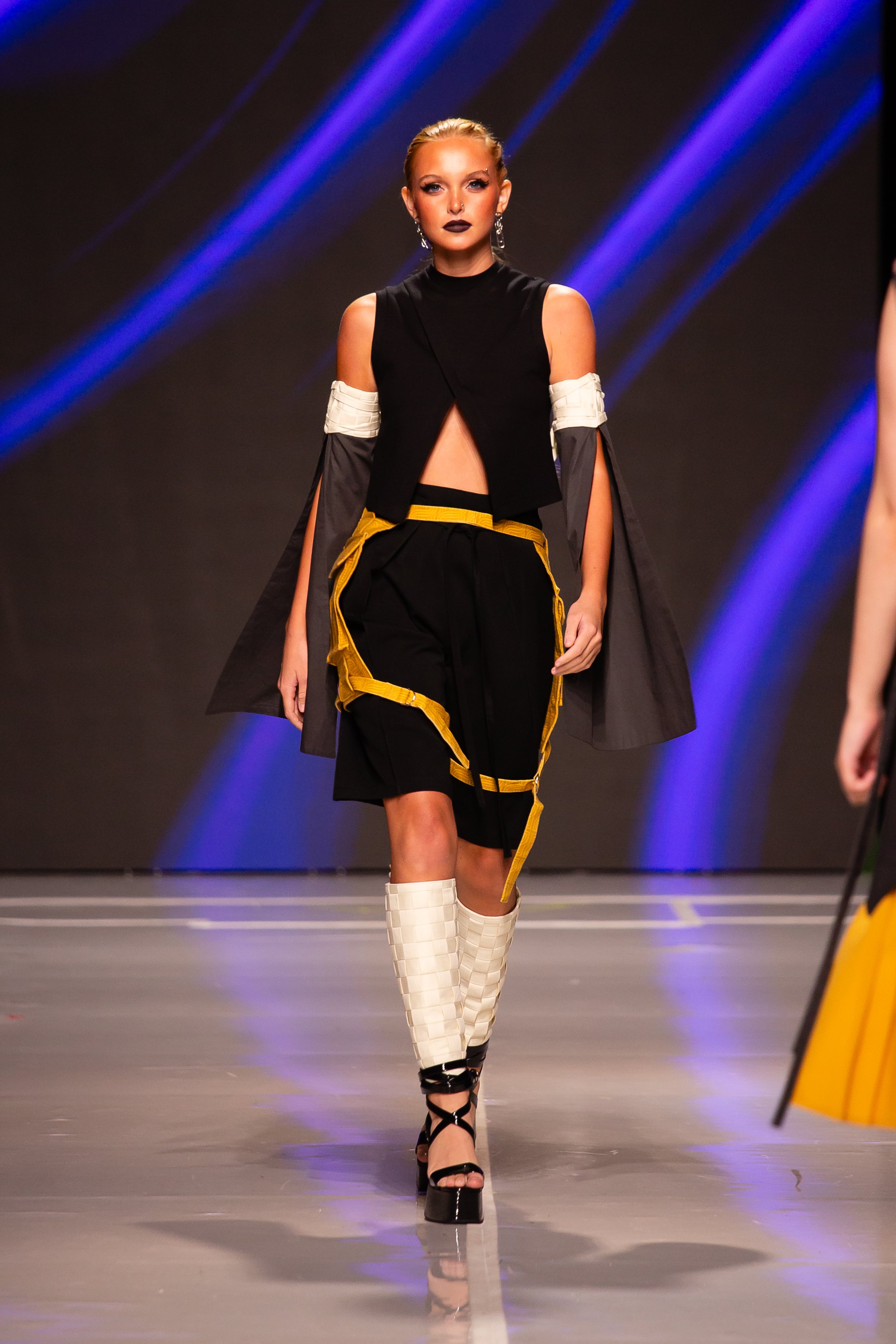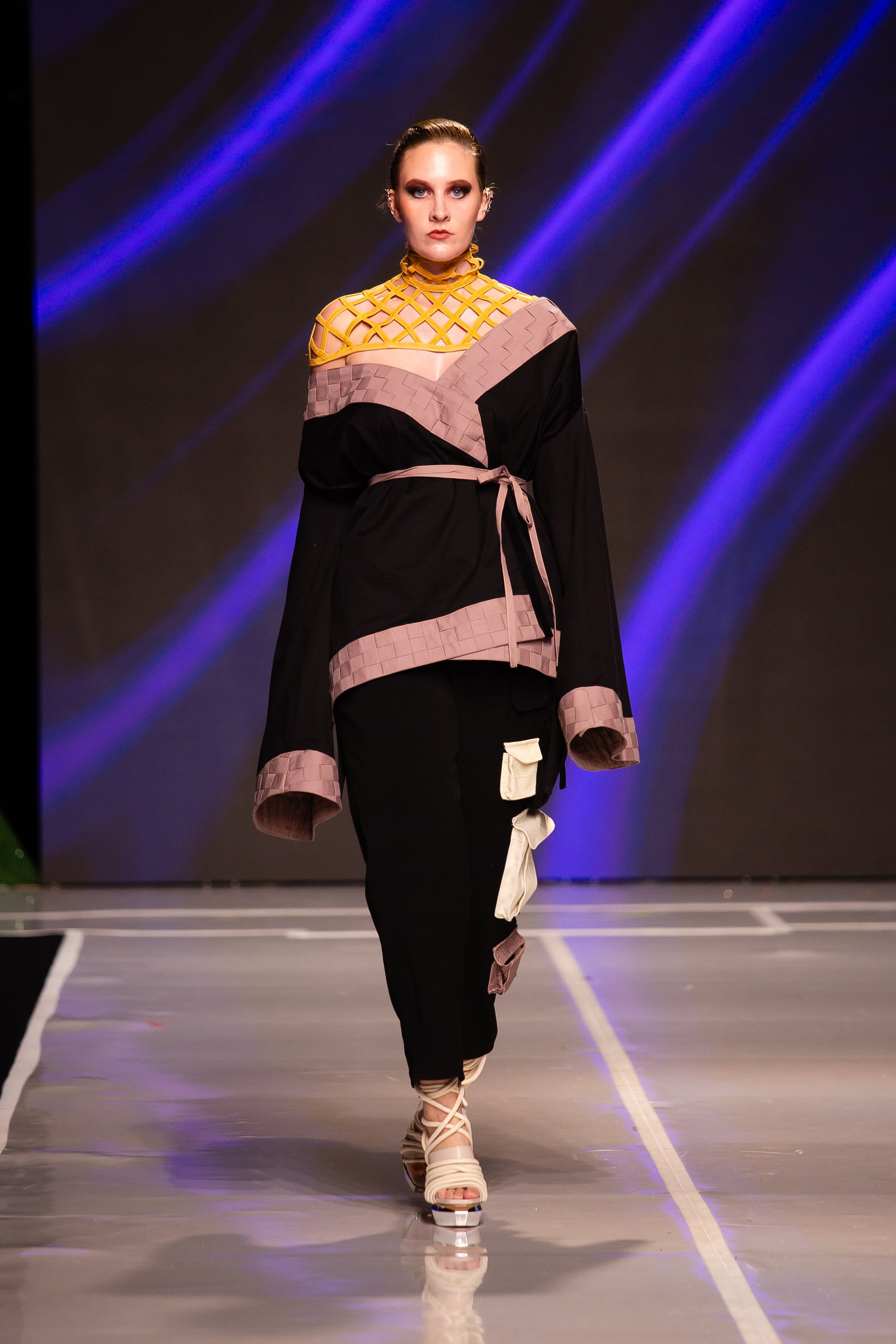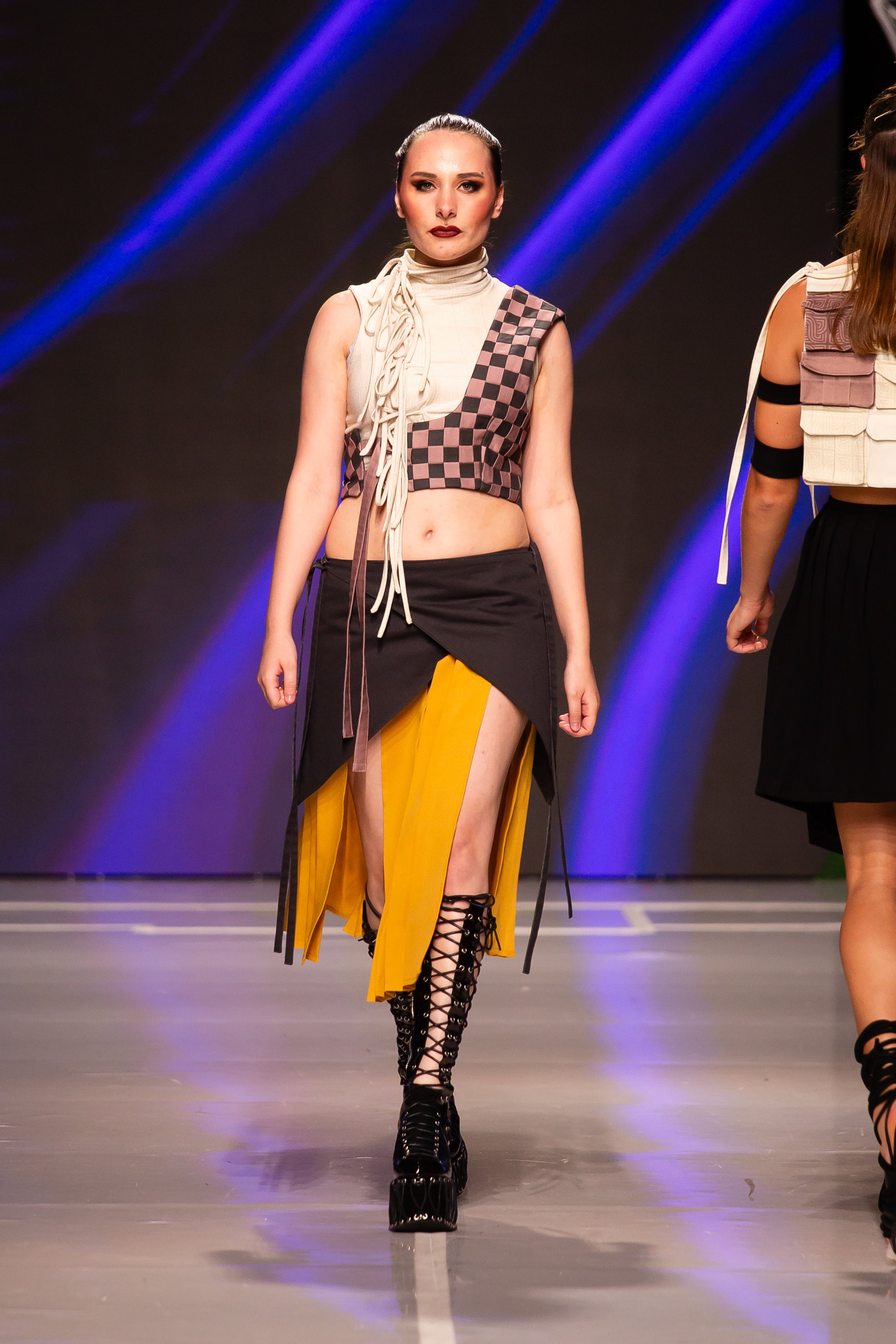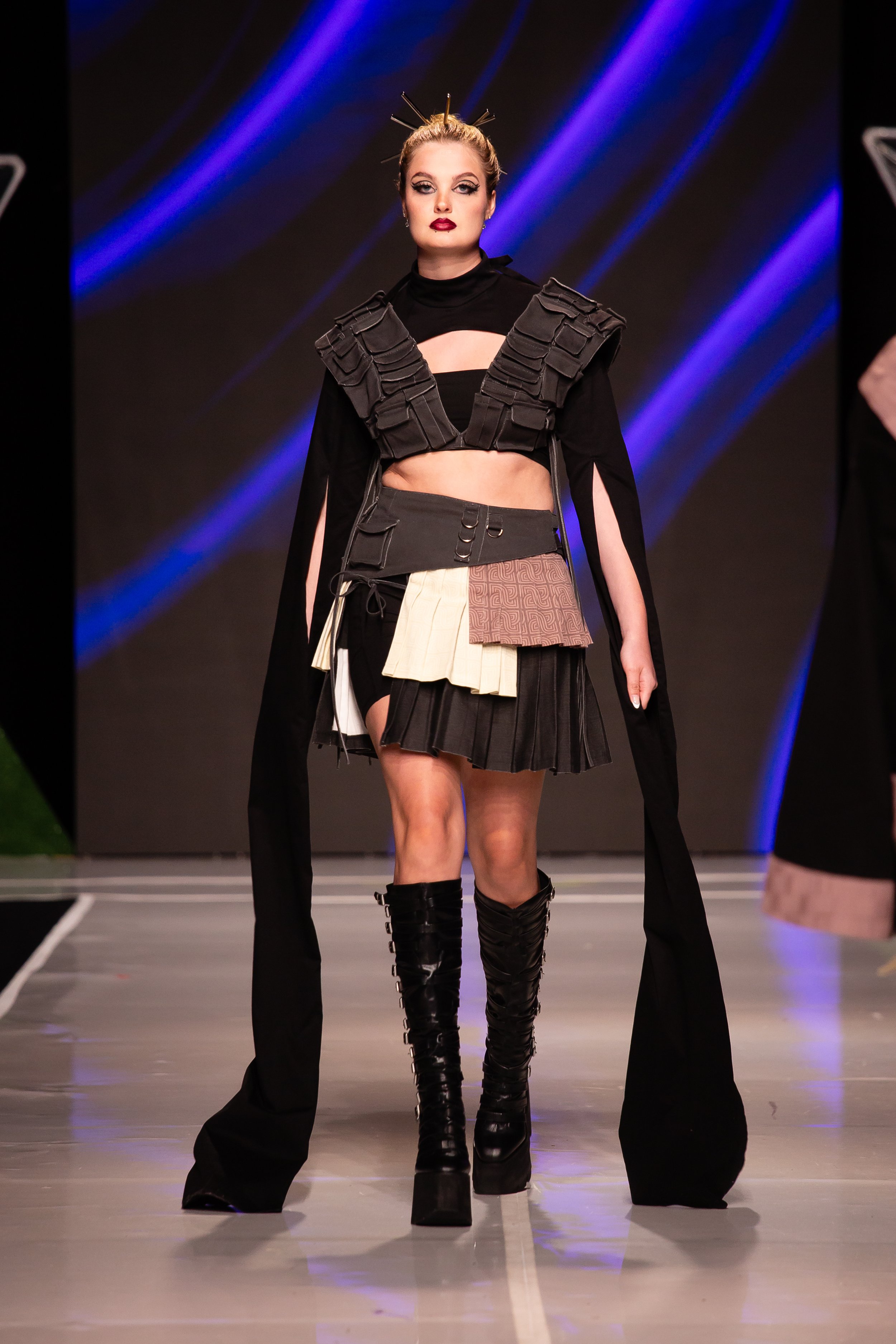Creating a Fashion Runway Collection
Written By Britney Spangenberg
Collection Presented at Omaha Fashion Week
Photographed By Heather & Jameson Photography
Models Provided By Develop Model Management
Modeled By Madi Haes Keziah Slinkard, Alyna Chadwhick, Liz Kopetzky, Tabitha Hogeuison, Riley Blankenship, Rose Deng, Hailey Van Horn, & Maura Tichota
I recently had the honor of presenting my second fashion collection as the headlining designer for Omaha Fashion Week’s Fauna Designer Showcase this past fall/winter 23/24 season. This past season, I created a nine-look collection inspired by woven elements and modularity. Single-handedly creating a fashion collection is a big hurdle, especially as an undergraduate fashion design student. There is a lot to organize and create, and because I had only just finished my junior year here at MSU, I did not have much time to produce the collection. Since so much goes into a fashion week other than creating the garments, I wanted to shed light on all the aspects of building a runway-ready fashion collection as a low-income college student.
Timeline:
Timing is key to the success of any large project and a nine-look fashion collection is certainly a looming task. This collection required me to be on top of a self-imposed schedule and manage my time and tasks efficiently. It is also important to note that I wasn’t able to start working on this collection until after the spring semester had ended. The show was during the first week of the following semester—giving me about three months to produce nine looks with 36 individual garments.
I started out by creating the idea and sketching. This process took several weeks, but I made sure to have my ideas finalized by May 20th to ensure I was ready to immediately jump into production after the spring semester ended. After sketching, it was time to detail the technical aspects of each garment (closures, how to finish hems and seams, etc.) Once I figured out how I was going to technically construct each piece, I chose fabrics, colors, and textiles that would be necessary to create the collection. The sourcing of these fabrics was time consuming because I needed consistency within the shades of each fabric type—I was unable to secure that for all fabric types I needed. This led to me deciding to take the more expensive route and get custom colors printed through Spoonflower, a site that allows you to print your own designs on fabric or a variety of other household items. However, this decision greatly pushed back my anticipated production timeline. Knowing that I would not be receiving my final fabrics until about a month into my production time forced me to create a strict schedule of patterning and prototyping my garments so that I was ready to hit the ground running when the fabric arrived.
After purchasing my fabrics and other necessary materials (and crying at the amount that left my bank account), I threw myself headfirst into patterning and prototyping my collection. I had to strategically choose which garments to work on. I decided to work on the woven parts of my collection first (as I needed the knit fabric to arrive before I could accurately pattern for its particular stretch factor) and because I did not have my model’s measurements yet, I needed to focus on loose-fitting garments that were adjustable. In the model selection process, designers got to choose from the model pool on June 9th, and I received my final model selection on June 19th. This meant that I had an entire month of work time where I would not have final fabrics or final measurements. I spent that month draping, patterning base garments, and brainstorming ways to add adjustability and modularity to my collection.
After my final fabrics arrived and I received my finalized model lineup, it was time to get serious and start production of the final garments. I made some calculations to create a schedule that would keep me focused. I had 36 garments to make in nine weeks which meant I would have to complete four garments a week to stay on top of schedule. If you have ever made your own pattern work, prototyped it, and then produced it, you know that it can take a while. Four garments a week was a lofty goal—one that I couldn’t physically achieve. I was working on this collection seven days a week for about 12 hours a day and was still unable to produce four well-made garments each week. Even without being able to follow my paced out timeline, I was in the studio chipping away at the collection with all I had until August 7th, which was when I traveled to Omaha to do model fittings and production details.
By the time August 7th rolled around, I was far from being finished with all 36 garments. Closer to the fittings, I started strategically picking garments that I knew would fit, and saved them for the three weeks after. I also stopped finishing garments completely and just made sure I had base garments to fit models into. This was also the time where I had to concern myself with accessories, hair, and shoes for my models so that I could order everything I needed and have it arrive on time, as we were shooting promotional content the same day as the fittings. As a headlining designer, I did not complete this step, but other designers can expect to meet with the panel and discuss their collection and its completion that same day as well. The fittings went well—only having to edit two garments—and when I got back to Springfield, I went straight back into production mode. I worked 24/7 up until I had to leave for Omaha on August 24th, the day before the show. That week was full of panicked sewing, attending classes, and worrying about not being able to sew while I was in class. I finished all the machine sewing for my collection two hours before I left for Omaha. I then hand-sewed my corset’s bustier cups during the car ride up there (each bustier cup took over 6 hours—which is the entire drive to Omaha from Springfield) and finished them in the hotel room. I also had one particular skirt that was not laying right and I knew I was running out of time. However, I knew it would bug me forever, so with the help of close friends, I tore apart the entire skirt and re-sewed it the night before I left for Omaha. My friends seam-ripped it apart for me while I was sewing another piece and later while I was leading my first executive meeting as Editor in Chief for Sartorial Magazine. I finished sewing the skirt back together after I finished leading my first general meeting for Sartorial during the one hour the building was open after the meeting. It was the most stressful sewing I have ever done in my entire life.
Show Production:
A lot goes into producing a show like Omaha Fashion Week, so I will only focus on the parts that I organized as a presenting designer. The biggest production detail that designers choose is the model selection. Omaha Fashion Week holds an open casting call every season and they take measurements, photos, and videos of the runway walk for every model that comes to the open casting call. They then place that information into a dropbox for the designers for model selection—this usually ends up yielding around 300 models. As the designer, you go through all 300 applicants and select your favorites based on the measurements you need, aesthetic of your collection, quality of their runway walk, and your past experience with them. As this was my second collection at Omaha, I reached out to my past models and requested their casting number so I could re-cast them. The selection process works by ranking your top 30 choices of models in order of importance. Alyssa Dilts, the head of Develop Model Management, who is partnered with Omaha Fashion Week, goes through and selects models for all designers based on rankings. For example, if I were to rank model #154 as my top choice and another designer ranked the same model as their third choice, I would receive model #154. This is why even if I only need 9 models, I rank 30 in total, to give Alyssa choices to work with. When I was selecting my models, the measurements were the biggest factor for me. As a fashion student who worked alone on this collection, I only had myself and the dress forms that the Merchandising and Fashion Design program provides to test the fit of my garments. I only had one fitting just three weeks before the show, which meant I needed to be 100% confident in the fit of my garments. Considering these factors, I needed to cast models with measurements close to my own.
Other production details that I went over with Omaha Fashion Week professionals was hair and makeup with the Omaha Fashion Week Beauty Alliance led by the SOHO Hair Academy. I provided mood and inspiration boards, and a lead stylist talked over my choices with me to solve any problems to ensure the looks could be completed within the time frame before the show. They also discussed what extra hair accessories or makeup I would need to purchase to make my desired looks possible. I also went over lighting, music selection, and imaging on the LED screen backdrop to create an entire atmosphere for my collection. Omaha Fashion week works with professionals in all fields and they were all able to assist me in choosing what would work best for my collection and show production.
Financials:
Creating a fashion collection is not a cheap endeavor, and as a broke college student, I was scrambling to come up with the money, especially with the amount of time I needed to work on the garments. I had to go on Academic Leave from my job for the three months I was working on this collection. I found out I would be returning to Omaha in the fall after my first collection shortly after I was announced the Emerging Designer Golden Shears Winner for the Fall/Winter 22/23 season. The minute I knew I was returning, I started saving. I worked every day possible, I pinched pennies, and I applied for scholarships upon scholarships. I was able to save a large sum of money in order to fund my collection, and I am sure the numbers will give some of you sticker shock.
In total, I spent right around $4,000 on this collection. I spent $2,481.36 on fabric alone. Let me break down the fabric cost: I fully lined all of my garments so they were produced to a higher quality. This essentially doubles the amount of fabric I need to have. All the woven elements in my collection were made by cutting strips and weaving them, greatly increasing the amount of fabric I would need. All of my fabrics were custom printed colors (custom is always higher than off-the-rack.) Plus, I had a mishap with my dark purple colorway through Spoonflower—it arrived looking gray and I had to scrap all my purchased dark purple fabric and repurchase off-the-rack black fabrics from surrounding fabric stores last minute. The remaining sum of money was spent on accessories, shoes, sewing notions, a coverstitch machine, business cards, hang tags, and professional photo and video packages. I did not include my hotel or travel costs in this amount, as I don’t really want to think about how expensive it was to stay in Omaha for just four days. Now, I want to make one thing very clear: you can create a collection at a much lower price point if you make just a few key decisions. You can buy cheaper fabrics like quilting cotton or only purchasing fabrics from cheaper deadstock stores like FM Stores in Springfield, have your models bring their own shoes, decide not to provide extras for styling like jewelry or hair accessories, not fully line all your garments, and make less elaborate and/or layered looks. My collection was more expensive because I had a very specific and intricate vision, and I worked my butt off to make it exactly how I envisioned it, even down to the inside of the garment.
Now, the financials are not all negative. I attended an event after the show called Shop the Runway Sunday. At this event, I had my entire collection available to purchase, and I was able to make a little over $750. I then sold some garments to customers outside of the event and made about $400 more. I only sold 5 garments in total—my fashion professor made sure I priced garments for what they were worth before I traveled to Omaha. Most of the collection is still up for sale and can be purchased by contacting me at nightcire.arts@gmail.com.
Overall, headlining for this past fall season of Omaha Fashion Week was one of the most fulfilling and exciting experiences I have had in my career so far, and I loved being in the atmosphere with all the amazing people that make Omaha Fashion Week happen! Even through all the late nights, fabric mishaps, models calling out two hours before the show, and my fingers being in pain during and for weeks afterward, I wouldn’t change a thing about it. I was able to go all out and create a showstopping collection that I will be proud of for the rest of my life. I encourage other design students to follow your passions, but to be realistic. Think over the timing, the financials, and whatever else might be a part of your life before you commit to a decision as big as creating a collection for the runway. It was an amazing experience, but as my friends can attest, they did not see me for the entirety of that summer as I did little else other than live and breathe the collection. Doing it in between semesters has left me drained and burnt out as I never got that greatly-needed break. If the timing, financials, and life situation all align, then don’t hesitate to chase your dreams.

